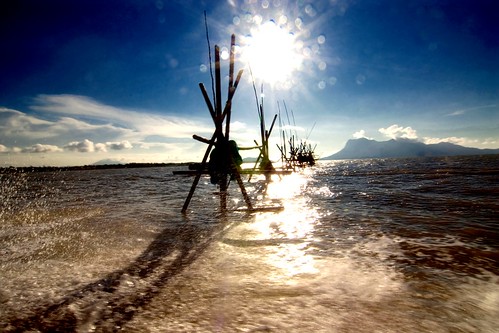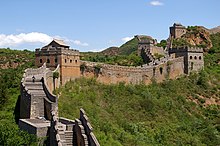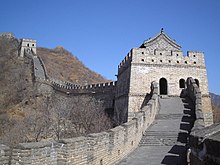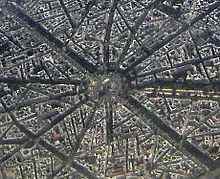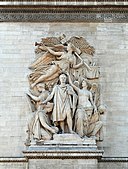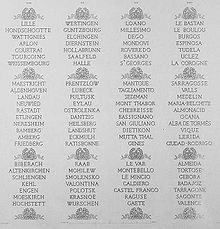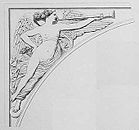Magic Kingdom is one of four theme parks at the Walt Disney World Resort located near Orlando, Florida. The first park built at the resort, Magic Kingdom opened Oct. 1, 1971. Designed and built by WED Enterprises, the park's layout and attractions are similar to Disneyland Park in Anaheim, California. In 2010, the park hosted approximately 17 million visitors, making it the most visited theme park in the world.

History
Construction
Although Walt Disney himself had been highly involved in planning
The Florida Project,
The Walt Disney Company began construction on Magic Kingdom and the
entire resort in 1967 after his death. The park was built similarly to
the existing Disneyland in California but was built in a larger area and
improved upon the design of Disneyland in several ways.
There are several anecdotes relating to reasons for some of the
features of Walt Disney World, and Magic Kingdom specifically. According
to one story, Walt Disney once saw a Frontierland cowboy walking through Tomorrowland
at Disneyland. He disliked that the cowboy intruded on the futuristic
setting of Tomorrowland and wanted to avoid situations like this in the
new park.
Therefore, Magic Kingdom was built over a series of tunnels called utilidors, a portmanteau of
utility and
corridor. These tunnels allow employees (aka cast members) to move through the park out of sight from guests, maintaining the show's cast.
Because of Florida's high water table, the tunnels could not be put
underground, so they were built at the existing grade. This means that
the park is actually built on the second story, giving Magic Kingdom an
elevation of 107 feet (33 m). The area around the utilidors was filled
in with dirt removed from the Seven Seas Lagoon, which was being constructed at the same time.
The utilidors were built in the initial construction and were not
extended as the park expanded. The tunnels were intended to be designed
into in all subsequent Walt Disney World parks, but these plans were
mostly set aside because of financial constraints. Future World at Epcot and Pleasure Island each have a smaller network of utilidors.
Opening
Magic Kingdom opened as the first part of Walt Disney's planned
Florida Project on Oct. 1, 1971. It was the only theme park on the
resort at the time and opened concurrently with two hotels on the
property: Disney's Contemporary Resort and Disney's Polynesian Resort.
The park opened with 23 attractions, three unique to the park and 20
copies of attractions at Disneyland. The Walt Disney Company promised to
increase this number with more attractions like those in Disneyland as
well as more unique ones. The attractions were split into six themed
lands, five copies of those at Disneyland and the unique Liberty Square.
While there is no individual dedication to Magic Kingdom Park, the dedication by Roy O. Disney for the entire Walt Disney World Resort was placed within its gates.
Since opening day, Magic Kingdom has only been closed for five incidents: Hurricane Floyd, the September 11 attacks, Hurricane Frances, Hurricane Charley, and Hurricane Wilma.
Naming confusions
Magic Kingdom had often been used as an unofficial nickname
for Disneyland Park before the Walt Disney World Resort was built. The
official tagline for Disneyland is
The Happiest Place On Earth, while the tagline for Walt Disney World's Magic Kingdom is,
The Most Magical Place On Earth. Despite the similarities, the Florida park's tickets have always borne the official name of
Magic Kingdom. In 1994, in order to differentiate it from Disneyland, the park was officially renamed to
Magic Kingdom Park but is most often simply called
Magic Kingdom.
Like all of Disney's theme parks it does not take an article ("the"),
however it is a common mistake to see it described as such. The sign on
the railroad station at the front of the park erroneously states "The
Magic Kingdom."
Transportation and Ticket Center
The layout of the resort places Magic Kingdom more than a mile away
from its parking lot, on the opposite side of the man-made Seven Seas
Lagoon. Upon arrival, guests are taken by the parking lot trams
to the Transportation and Ticket Center (TTC), which sells tickets to
the parks and provides transportation connections throughout the resort
complex. It also has a small gift shop and the central lost-and-found
facility for all four theme parks.

Entry arch for the Magic Kingdom line from the TTC
To reach Magic Kingdom, guests either use the Walt Disney World Monorail System, the Staten Island-style ferryboats, or Buses depending on the location of their hotel. The three hotels closest to Magic Kingdom, Disney's Contemporary Resort, Disney's Polynesian Resort, and Disney's Grand Floridian Resort and Spa
use either the ferry or monorail system to travel to Magic Kingdom.
Guests staying at Disney's Wilderness Lodge and Disney's Fort Wilderness
Campground can also ride a dedicated ferry boat to the Magic Kingdom
docks. The other hotels take the buses to travel to this specific park.
The three ferries are clad in different trim colors and are named for
past Disney executives: the General Joe Potter (blue), the Richard F. Irvine (red) and the Admiral Joe Fowler (green).
The main monorail loop has two lanes. The outer lane is a direct
nonstop loop between the TTC and Magic Kingdom. The inner loop has
additional stops at Disney's Contemporary Resort, Disney's Polynesian
Resort and Disney's Grand Floridian Resort & Spa. Epcot is accessible by a spur monorail line that was added upon that park's opening in 1982.
Lands of the Magic Kingdom

Cinderella Castle at night with Christmas Dream Lights

Wishes: A Magical Gathering of Disney Dreams is the largest fireworks show ever presented at the Magic Kingdom

Swiss Family Robinson Treehouse

Big Thunder Mountain Railroad
The park map lists 46 attractions in six themed "lands." Designed like a wheel with the hub in front of Cinderella Castle, pathways spoke out across the 142 acres (0.57 km
2) of the park and lead to these six lands. The Walt Disney World Railroad runs along the perimeter of the park and makes stops at Main Street, U.S.A. and Frontierland.
Main Street, U.S.A.
Instead of being a replica of a small Midwestern American town, Main Street at Magic Kingdom features some stylistic influences from around the country. Taking its inspiration from New England to Missouri,
this design is most noticeable in the four corners area in the middle
of Main Street, where each of the four corner buildings represents a
different architectural style. There is also no opera house on Magic
Kingdom's Main Street as there is at Disneyland; instead, there is the
Town Square Theater. Also, this is where Christopher George Weaver, the
"mayor" of Main Street U.S.A., and one of the park's most important
figures, resides.
Main Street is lined with shops selling merchandise and food. The
decor is early-20th century small-town America, inspired by Walt
Disney's childhood and the film
Lady and the Tramp. City Hall contains the Guest Relations lobby, where cast members provide information and assistance. A working barber shop gives haircuts
for a fee. The Emporium carries a wide variety of Disney souvenirs such
as plush toys, collectible pins and Mickey-ear hats. Tony’s Town Square
Restaurant and The Plaza Restaurant are table-service locations.
Casey's Corner is at the end of Main Street and sells traditional
American ballpark fare including hot dogs and fries. The Main Street Confectionary sells sweets priced by their weight, such as candied apples, crisped rice treats, chocolates, cookies and fudge.
Most windows on Main Street bear the name of people who were
influential at Walt Disney World or other Disney parks. An example of a
classic Main Street, U.S.A. attraction is the Walt Disney World
Railroad, which transports guest throughout the park, making stops at
Main Street, U.S.A. Fantasyland, and Frontierland. The railroad's
previous stop at Mickey's Toon Town Fair was replaced by the Fantasyland
stop in 2012.
In the distance beyond the end of Main Street stands Cinderella Castle. Though only 189 feet (55m) tall, it benefits from a technique known as forced perspective.
The second stories of all the buildings along Main Street are shorter
than the first stories, and the third stories are even shorter than the
second, and the top windows of the castle are much smaller than they
appear. The resulting visual effect is that the buildings appear to be
larger and taller than they really are.
Symbolically, Main Street, U.S.A. represents the park's "opening
credits". Guests pass under the train station (the opening curtain),
then view the names of key personnel along the windows of the buildings'
upper floors. Many windows bear the name of a fictional business, such
as "Seven Summits Expeditions, Frank G. Wells
President", with each representing a tribute to significant people
connected to the Disney company and the development of the Walt Disney
World Resort.
The park contains two additional tributes: the
Partners statue of Walt Disney and Mickey Mouse in front of Cinderella Castle and the
Sharing the Magic statue of Roy O. Disney sitting with Minnie Mouse in the Town Square section of Main Street, U.S.A. Both were sculpted by veteran Imagineer Blaine Gibson.
Adventureland
Adventureland represents the mystery of exploring foreign lands. It
is themed to resemble the remote jungles in Africa, Asia, the Middle
East, South America and the South Pacific, with an extension resembling a
Caribbean town square. It contains classic rides such as Pirates of the Caribbean and Jungle Cruise.
Frontierland
Frontierland is where guests can relive the American Old West
– from cowboys and Indians, to exploring the mysteries of the Rivers of
America. Frontierland contains classic attractions such as Big Thunder Mountain Railroad, Splash Mountain, and the Country Bear Jamboree.
Liberty Square
This area of the park is based on an American Revolutionary colonial town. The Magic Kingdom's Rivers of America hosts the
Liberty Belle riverboat. Liberty Square is home to The Haunted Mansion and the Hall of Presidents.
Fantasyland
In the words of Walt Disney: "Fantasyland is dedicated to the young
at heart and to those who believe that when you wish upon a star, your
dreams come true." Fantasyland is themed in a medieval-faire/carnival
style.
Attractions include "it's a small world", Peter Pan's Flight, The Many Adventures of Winnie the Pooh, Mickey's PhilharMagic, Snow White's Scary Adventures, Prince Charming Regal Carrousel, and Mad Tea Party.
Expansion
The land is currently undergoing a large expansion and renovation.
"The New Fantasyland will be constructed in phases with most new
experiences open by late 2012."
Recent conceptual artwork for the expansion shows several new additions and changes.
Included is a new dark ride themed to Disney's 1989 film
The Little Mermaid (also opened at Disney California Adventure).
The ride is going through testing, and will be released after the
Storybook Circus. There will also be an area themed to Disney's 1991
film
Beauty and the Beast featuring The Beast's Castle with a new dining experience, Gaston's tavern, and Belle's cottage.
Snow White's Scary Adventures will be removed and an area themed to Disney's 1937 film
Snow White and the Seven Dwarfs will be built. It will feature Snow White's
cottage and The Seven Dwarfs mine train roller coaster ride, the first
rollercoaster to move in a wobbling motion on track. Princess Fairytale
Hall, a new Disney Princess meet and greet will be established where Snow White's Scary Adventures currently exists
.
Mickey's Toontown Fair closed permanently in February 2011 in order to make way for the expansion.
Some elements of Mickey's Toontown Fair will be demolished and others
will be re-themed to a new Storybook Circus area. An expanded Dumbo the Flying Elephant
ride will be built with an interactive queue. A second Dumbo the Flying
Elephant will be built next to it in order to increase capacity. The
Barnstormer at Goofy's Wiseacre Farm was re-themed to The Great Goofini."
A Casey Jr. mini-water park will be released soon. A big top area will be built for meet-and-greets.
Storybook Circus
Storybook Circus, part of the aforementioned Fantasyland expansion is
currently in progress. It is located at the former site of Mickey's
Toontown Fair. Attractions include The Great Goofini and Dumbo the Flying Elephant,
which was removed from its current location in Fantasyland on January
8, 2012 and an expanded duplication is being built here. Storybook
Circus began soft openings on March 12, 2012. The rest of the area was
opened on March 31, 2012. On the map, this is part of Fantasyland.
Tomorrowland
In the words of Walt Disney: "Tomorrow can be a wonderful age. Our
scientists today are opening the doors of the Space Age to achievements
that will benefit our children and generations to come. The Tomorrowland
attractions have been designed to give you an opportunity to
participate in adventures that are a living blueprint of our future."
Tomorrowland is themed to be an intergalactic city; a concept of the
future as seen from around the 1950s: rockets, UFOs and robots, etc.
Classic attractions include Space Mountain, Carousel of Progress, Astro Orbiter, Tomorrowland Transit Authority and the Tomorrowland Speedway. Other current attractions include Stitch's Great Escape, Buzz Lightyear's Space Ranger Spin and Monsters, Inc. Laugh Floor.
Former lands
Mickey's Toontown Fair
Main article: Mickey's Toontown Fair
An expansion of the land created as
Mickey's Birthdayland, and later
Mickey's Starland, this area was home to attractions such as Mickey's Country House, Minnie's Country House, The Barnstormer at Goofy's Wiseacre Farm, and Donald's Boat.
This land closed permanently on February 12, 2011 to make way for the
expansion of Fantasyland. The Walt Disney World Railroad station in
Mickey's Toontown Fair was closed for the duration of the construction.
Planned film
Director Jon Favreau and Walt Disney Pictures plan to produce and release a film concerning a family at Disneyland which finds the theme park characters and attractions coming to life.
Favreau, who said "the Disney iconography was probably the first set
of archetypes that I was exposed to" and that Disney movies and
attractions "made a deep impression on me as a child", noted that, "When
I first heard about the ['Magic Kingdom' film] project, I was on my way
to visit Disneyland with my family. I took notes and had no problem
filling a book with all the ideas that this concept offered, even on
first blush."
Marc Abraham and Eric Newman of Strike Entertainment are scheduled to produce the film.
Writer-producer Ronald D. Moore
had previously written an original script for the project, which the
studio eventually declined to use, stating that Favreau and a new screenwriter will develop a new script.
On June 20, 2011, Novelist, Michael Chabon signed on to write the film's script.
